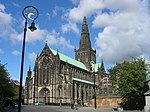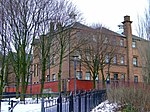Provand's Lordship
15th-century establishments in ScotlandBuildings and structures completed in 1471Category A listed buildings in GlasgowDefunct hospitals in ScotlandHistoric house museums in Glasgow ... and 3 more
Hospitals in GlasgowListed houses in ScotlandUse British English from February 2018

The Provand's Lordship of Glasgow, Scotland, is a medieval historic house museum located at the top of Castle Street within sight of the Glasgow Cathedral and Glasgow Royal Infirmary, and next to the St Mungo Museum of Religious Life and Art.
Excerpt from the Wikipedia article Provand's Lordship (License: CC BY-SA 3.0, Authors, Images).Provand's Lordship
Castle Street, Glasgow Townhead
Geographical coordinates (GPS) Address Website External links Nearby Places Show on map
Geographical coordinates (GPS)
| Latitude | Longitude |
|---|---|
| N 55.8624 ° | E -4.2369 ° |
Address
Provand's Lordship
Castle Street 3
G4 0RB Glasgow, Townhead
Scotland, United Kingdom
Open on Google Maps









